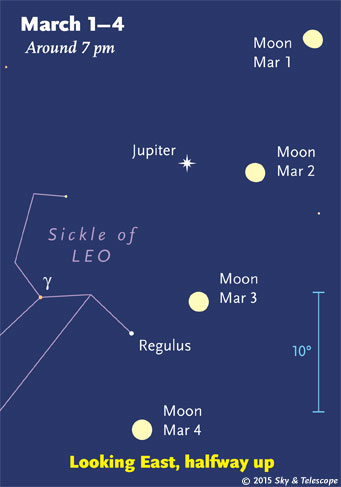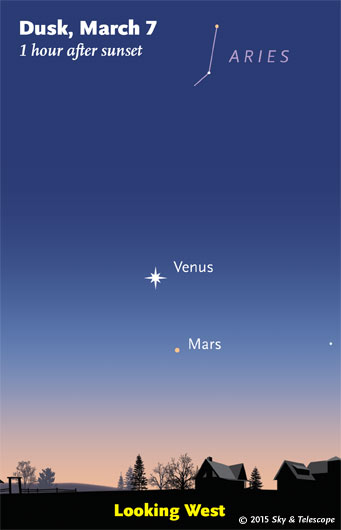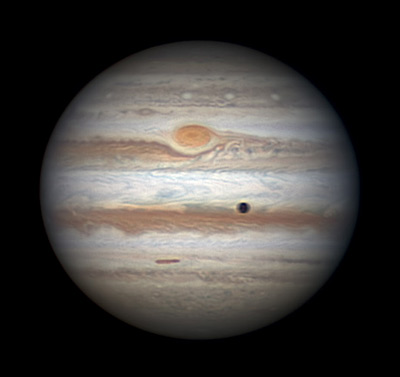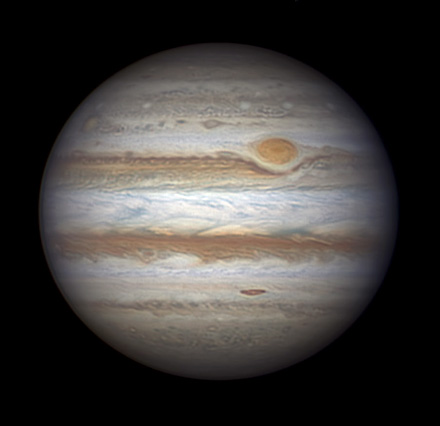Some daily sky sights among the ever-changing Moon, planets, and stars.

Friday, February 27
Venus and Mars in the western twilight have widened to be 2.7° apart now. Look for faint Mars beneath Venus.
Saturday, February 28
Early this evening, the dark limb of the waxing gibbous Moon will occult (cover) the 3.6-magnitude star Lambda Geminorum for telescope users in North America east of the Mississippi and north of the deepest South. Some times: central Massachusetts, 8:00 p.m. EST; Washington DC, 7:56 p.m. EST; Chicago, 6:31 p.m. CST (in twilight); Kansas City, 6:21 p.m. CST (in twilight). See map and detailed timetables of both the disappearance and the (unobservable) reappearance; be careful not to mix these up when scrolling down the table.
Two mutual events among Jupiter's moons. Watch Europa occult (pass in front of) Io from 11:10 to 11:16 p.m. EST this evening. At the center of this time, their combined light is dimmed by 0.6 magnitude, not quite half.
Then less than an hour later, Europa casts its shadow onto Io from 12:02 to 12:09 a.m. EST, dimming Io by 0.9 magnitude at the mid-time of this eclipse.
Watch Christopher Go's highly magnified videos of Europa occulting Io and then Europa eclipsing Io on February 18th. (The gray spot at the center of each satellite is a processing artifact.)
Sunday, March 1
After dark, Jupiter is the bright "star" to the Moon's lower left, and Procyon is the real star to the Moon's right. Far lower right of there shines Sirius, the brightest star in the sky. Sirius is also the nearest star that's visible to the naked eye from northern latitudes, at a distance of 8.6 light-years.
Monday, March 2
The bright planet near the waxing gibbous Moon tonight is Jupiter. Looks are deceiving, however. Jupiter is actually 40 times larger than the Moon in diameter, but it's 1,660 times farther away (as of tonight).
Another mutual event among Jupiter's moons. Tonight Ganymede occults Io from 11:06 to 11:11 p.m. EST; their combined light dims by 0.6 magnitude at the center of this time. Later Ganymede casts its shadow onto Io, but just a few minutes beforehand, Io disappears behind Jupiter's edge from Earth's viewpoint! (at 12:17 a.m. EST).
Tuesday, March 3
Bright Jupiter shines above the Moon this evening. Spot fainter Regulus closer to the Moon's lower left (for North America).
Wednesday, March 4
A challenge for North Americans as twilight turns into night: Distant Uranus, magnitude +5.9, glimmers just below Venus, which is 8,000 times brighter at magnitude –3.9. Use good binoculars or a telescope. At the time of nightfall on the East Coast, Uranus is 0.3° below Venus. By nightfall on the West Coast it's 0.5° below. Nothing else of that brightness is that close under Venus.
Thursday, March 5
Full Moon (exact at 1:05 p.m. Eastern Standard Time). This evening the Moon shines below the dim hind feet of Leo.
And another! Io partially eclipses Ganymede with its shadow from 1:35 to 1:46 a.m. Friday morning EST. Ganymede will dim by a full 1.0 magnitude at mid-eclipse. They're both to Jupiter's west – with Callisto in the background between them! Callisto is normally 1.1 magnitude fainter than Ganymede (which is the one appearing closest to Jupiter). But at mid-eclipse Ganymede will look almost identical to Callisto, with Io clearly outshining them both.

Friday, March 6
As the stars come out at this time of year, look due south for Orion standing upright at his highest. As night deepens, dim Lepus, the Hare, emerges under his feet. Below Lepus is Columba, the Dove.
Saturday, March 7
Little Mars has sunk to 6° below Venus now in the west at dusk. The gap between them will continue to widen until Mars finally becomes lost in the sunset in late April.
Daylight-saving time begins at 2 a.m. Sunday morning for most of the U. S. and Canada. Clocks spring ahead one hour.
But wait, there's more! Now Europa occults Io, from 1:15 to 1:21 a.m. Sunday morning EST. The blend of the two dims by just 0.5 magnitude at mid-event. They're the pair closest to Jupiter. Then exactly one hour after the end of that event, Europa's shadow starts eclipsing Io for 6 minutes, dimming it by 0.8 magnitude at mid-eclipse.
Similar mutual events happen among Jupiter's moons through the rest of the month; see the March Sky & Telescope, page 53. If you're not in North America, here's where to get the whole list worldwide, sortable by visibility from your location. These "mutual event seasons" happen about every 6 years. The current one will trail off later this spring.
Want to become a better astronomer? Learn your way around the constellations. They're the key to locating everything fainter and deeper to hunt with binoculars or a telescope.
This is an outdoor nature hobby; for an easy-to-use constellation guide covering the whole evening sky, use the big monthly map in the center of each issue of Sky & Telescope, the essential guide to astronomy. Or download our free Getting Started in Astronomy booklet (which only has bimonthly maps).

Once you get a telescope, to put it to good use you'll need a detailed, large-scale sky atlas (set of charts). The standards are the little Pocket Sky Atlas, which shows stars to magnitude 7.6; the larger and deeper Sky Atlas 2000.0 (stars to magnitude 8.5); and once you know your way around, the even larger Uranometria 2000.0 (stars to magnitude 9.75). And read how to use sky charts with a telescope.
You'll also want a good deep-sky guidebook, such as Sue French's Deep-Sky Wonders collection (which includes its own charts), Sky Atlas 2000.0 Companion by Strong and Sinnott, the bigger Night Sky Observer's Guide by Kepple and Sanner, or the beloved if dated Burnham's Celestial Handbook.
Can a computerized telescope replace charts? Not for beginners, I don't think, and not on mounts and tripods that are less than top-quality mechanically (able to point with better than 0.2° repeatability, which means fairly heavy and expensive). As Terence Dickinson and Alan Dyer say in their Backyard Astronomer's Guide, "A full appreciation of the universe cannot come without developing the skills to find things in the sky and understanding how the sky works. This knowledge comes only by spending time under the stars with star maps in hand."
This Week's Planet Roundup


Mercury (magnitude 0.0) glimmers just above the east-southeast horizon during dawn, a little lower every day. Bring binoculars.
Venus (magnitude –3.9) and Mars (less than 1% as bright at magnitude +1.3) are in the west-southwest during evening twilight. Look for Mars below Venus.
Jupiter (magnitude –2.5, in Cancer) comes into view high in the east during twilight. By 9 or 10 p.m. Jupiter is nearly as high as it will get. In a telescope Jupiter is still a big 44 arcseconds wide at its equator.
Saturn (magnitude +0.4, at the head of Scorpius) rises around 1 or 2 a.m. It's best placed in the south as dawn begins. Lower left of Saturn by 8° is orange Antares.
Look just ½° below Saturn in early dawn for Nu Scorpii, a showpiece double star for telescopes. Less than 2° to their right is Beta Scorpii, an even finer telescopic double.
Uranus (magnitude 5.8, in Pisces) is in the background of Venus just after dark.
Neptune is hidden in the glare of the Sun.
All descriptions that relate to your horizon — including the words up, down, right, and left — are written for the world's mid-northern latitudes. Descriptions that also depend on longitude (mainly Moon positions) are for North America.
Eastern Standard Time (EST) is Universal Time (UT, UTC, or GMT) minus 5 hours.
“This adventure is made possible by generations of searchers strictly adhering to a simple set of rules. Test ideas by experiments and observations. Build on those ideas that pass the test. Reject the ones that fail. Follow the evidence wherever it leads, and question everything. Accept these terms, and the cosmos is yours.”
— Neil deGrasse Tyson, 2014.
 0
0
Comments
You must be logged in to post a comment.